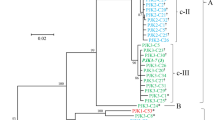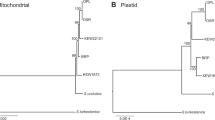Abstract
This study describes the organization of the repetitive pattern in the mtDNA control region of Tomistoma schlegelii. Using newly designed primers, we detected length variations of approximately 50–100 bp among individuals, and only one individual showed a heteroplasmic band. Sequencing the region after CSB III revealed two main patterns: a repeat motif and a variable number tandem repeat (VNTR) pattern. The VNTR region, with a core unit of 104 bp, consisting of four motifs and a short AT chain, is implicated in the length variation seen among individuals of Tomistoma. A conserved motif seen in a family unit indicated that the repeat pattern was stably inherited from the maternal parent to all offspring. A combination of VNTR patterns specific to different crocodilians was seen in Tomistoma, and the overall secondary structure was shown to be similar to that in Crocodylus and Gavialis.




Similar content being viewed by others
References
Arnason E, Rand DM (1992) Heteroplasmy of short tandem repeats in mitochondrial DNA of Atlantic cod, Gadus morhua. Genetics 132:211–220
Auliya M, Schwedick B, Sommerlad R, Brend S, Samedi (2006) A short-term assessment of the conservation status of Tomistoma schlegelii (Crocodylia: Crocodylidae) in Tanjung Puting National Park (Central Kalimantan, Indonesia). Cooperative survey by the Orangutan Foundation (UK) and the Tomistoma Task Force of the IUCN/SSC Crocodile Specialist Group
Bezuijen MR, Webb GJ, Hartoyo P, Samedi (2001) Peat swamp forest and the false gharial (Tomistoma schlegelii) in the Merang River, eastern Sumatra, Indonesia. Oryx 35:301–307
Brochu CA (2003) Phylogenetic approaches toward crocodylian history. Annu Rev Earth Planet Sci 31:357–397
Brochu CA (2009) Crocodylians (Crocodylia). In: Hedges SB, Kumar S (eds) The timetree of life. Oxford University Press, Oxford
Broughton R, Dowling TE (1994) Length variation in mitochondrial DNA of the minnow Cyprinella spiloptera. Genetics 138:179–190
Brown JR, Beckenbach K, Beckenbach AT, Smith MJ (1996) Length variation, heteroplasmy and sequence divergence in the mitochondrial DNA of four species of sturgeon (Acipenser). Genetics 142:525–535
Casane D, Dennebouy N, Rochambeau H, Mounolou JC, Monnerot M (1994) Genetic analysis of systematic mitochondrial heteroplasmy in rabbits. Genetics 138:471–480
Cesaroni D, Venanzeti F, Allegrucci G, Sbordoni V (1997) Mitochondrial length variation and heteroplasmy in natural population of the European sea bass, Dicentrarchus labrax. Mol Biol Evol 14:560–568
Chong LK, Tan SG, Yusoff K, Siraj SS (2000) Identification and characterization of Malaysian river catfish, Mystus nemurus (C&V): RAPD and ALFP analysis. Biochem Genet 38:63–76
Delport W, Ferguson JWH, Bloomer P (2002) Characterization and evolution of the mitochondrial DNA control region in hornbills (Bucerotiformes). Mol Evol 54:794–806
Hauswirth WW, Walle MJVD, Laipis PJ, Olivo PD (1984) Heterogeneous mitochondrial DNA D-loop sequences in bovine tissue. Cell 37:1001–1007
IUCN (2009) Red List of Threatened Species version 2009. www.iucnredlist.org. Downloaded 3 August 2009
Janke A, Gullberg A, Sandrine H, Aggarwal RA, Arnason U (2005) Mitogenomic analyses place the gharials (Gavialis gangeticus) on the crocodile tree and provide pre-K/T divergence times for most crocodilians. Mol Evol 61:620–626
Kim JH, Eizirik E, O’Brien SJ, Johnson WE (2001) Structure and patterns of sequence variation in the mitochondrial DNA control region of the great cats. Mitochondrion 14:279–292
Koehler CM, Lindberg GL, Brown DR, Beitz DR, Freeman AE, Mayfield DR, Mayers AM (1991) Replacement of bovine mitochondrial DNA by a sequence variant within one generation. Genetics 129:247–255
Kumazawa Y, Endo H (2004) Mitochondrial genome of the Komodo dragon: efficient sequencing method with reptile-oriented primers and novel gene rearrangements. DNA Res 11:115–125
Larizza A, Pesole G, Reyes A, Sbisa E, Saccone C (2001) Lineage specificity of the evolutionary dynamics of the mtDNA D-loop region in rodents. Mol Evol 54:145–155
Levinson G, Gutman GA (1987) Slipped-strand mispairing: a major mechanism for DNA sequence evolution. Mol Biol Evol 4:203–221
Ludwig A, May B, Lutz D, Jenneckens I (2000) Heteroplasmy in the mtDNA control region of sturgeon (Acipenser, Huso and Scaphirhynchus). Genetics 156:1933–1947
Lutz S, Weisser H, Heizmann J, Pollak S (1999) Mitochondrial heteroplasmy among maternally related individuals. Int J Legal Med 113:155–161
Mathews DH, Disney MD, Childs JL, Schroeder SJ, Zuker M, Turner DH (2004) Incorporating chemical modification constraints into a dynamic programming algorithm for prediction of RNA secondary structure. Proc Natl Acad Sci 101:7287–7292
Mjelle KA, Karlsen BO, Jorgensen TE, Moum T, Johansen SD (2008) Halibut mitochondrial genomes contain extensive heteroplasmic tandem repeat arrays involved in DNA recombination. BMC Genomics 9(10). doi:10.1186/1471-2164-9-10
Nesbo CL, Arab MO, Jakobsen KS (1998) Heteroplasmy, length and sequence variation in the mtDNA control regions of three percid fish species (Perca fluviatilis, Acerina cernua, Stizostedion lucioperca). Genetics 148:1907–1919
Nilsson M (2009) The structure of the Australian and South American marsupial mitochondrial control region. Mitochondr DNA 20(5):126–138
Pavelitz T, Rusche L, Matera AG, Scharf JM, Weiner AM (1995) Concerted evolution of the tandem array encoding primate U2 snRNA occurs in situ, without changing the cytological context of the RNU2 locus. EMBO J 14:169–177
Petri B, Haeseler A, Paabo S (1996) Extreme sequence heteroplasmy in bat mitochondrial DNA. Biol Chem 377:661–667
Rand DM, Harrison RG (1989) Molecular population genetics of mtDNA size variation in crickets. Genetics 121:551–569
Ray DA, Densmore LD (2002) The crocodilian mitochondrial control region: general structure, conserved sequences and evolutionary implications. J Exp Zool 294:334–345
Ray DA, Densmore LD (2003) Repetitive sequences in the crocodilian mitochondrial control region: poly-A sequences and heteroplasmic tandem repeats. Mol Biol Evol 20(6):1006–1013
Roos J, Aggarwal RK, Janke A (2007) Extended mitogenomic phylogenetic analyses yield new insights into crocodylian evolution and their survival of the Cretaceous-Tertiary boundary. Mol Biol Evol 45:663–673
Roques S, Godoy JA, Negro JJ, Hiraldo F (2004) Organization and variation of the mitochondrial control region in two vulture species, Gypaetus barbatus and Neophron percnopterus. Heredity 95(4):332–337
Sbisa E, Tanzariello F, Reyes A, Pesole G, Saccone C (1997) Mammalian mitochondrial D-loop region structural analysis: identification of new conserved sequences and their functional and evolutionary implications. Gene 205:125–140
Snall N, Huoponen K, Savontaus M-L, Ruohomaki K (2002) Tandem repeats and length variation in the mitochondrial DNA control region of Epirrita autumnata (Lepidoptera: Geometridae). Genome 45:855–861
Soong DL, Chang HS, Ki BK, Yoon SL, Jung BL (1997) Sequence variation of mitochondrial DNA control region in Koreans. Forensic Sci Int 87:99–116
Tamura K, Dudley J, Nei M, Kumar S (2007) Mega4: Molecular Evolutionary Genetics Analysis (Mega) software version 4.0. Mol Biol Evol 24:1596–1599
Taylor JS, Breden F (2000) Slipped-strand mispairing at noncontiguous repeats in Poecilia reticulata: a model for minisatellite birth. Genetics 155:1313–1320
Walberg MW, Clayton DA (1981) Sequence and properties of the human KB cell and mouse L cell D-loop regions of mitochondrial DNA. Nucleic Acids Res 24:5411–5421
Wilkinson GS, Chapman AM (1991) Length and sequence variation in evening bat D-loop mtDNA. Genetics 128:607–617
Wilkinson GS, Mayer F, Kerth G, Petri B (1997) Evolution of repeated sequence arrays in the D-loop region of bat mitochondrial DNA. Genetics 146:1035–1048
Acknowledgments
We would like to thank the directors general Dato Abdul Rasid Samsudin of the Department of Wildlife and National Parks, Peninsular Malaysia (Perhilitan), and Dato Haji Len Talif Salleh of the Forest Department of Sarawak and Sarawak Forestry Corporation (SFC) for permits and permission to carry out this work. We extend our appreciation to the officers of these government bodies: Dr. Sandie Choong, Dr. Abraham Matthews, and Mr. Rauf Kadir (Perhilitan); Mr. Shahbudin Sabki (Forest Department Sarawak); Mr. Engkamat Lading (SFC); and all their staff who assisted with sample collection. We also thank Zoo Negara, Melaka Zoo, Taiping Zoo, Temerloh Mini Zoo, the crocodile farms in Kuching and Miri, Sarawak, and their personnel for assisting with sample collection. This work was funded by Universiti Tunku Abdul Rahman (UTAR); SOS Rhino, Sabah, Malaysia; the Zoological Society for the Conservation of Species and Population (Zoologische Gesellschaft für Arten- und Populationsschutz, ZGAP); and BOH Plantations Sdn. Bhd.
Author information
Authors and Affiliations
Corresponding author
Electronic supplementary material
Below is the link to the electronic supplementary material.
Supplementary Fig. 1
Sequence alignment of the repetitive region generated after CSB III using primer L15790. The 3’ portion of CSB III is indicated. Motifs R1 and R2 in the motif region are indicated in bold. The VNTR sequence is shaded, and the motifs in the tandem repeats are in bold. The first 6 individuals are members of a family unit, with TK008 being the maternal parent. The heteroplasmic bands of TK011 are indicated as “short” for the 2.8 kb band and “long” for the 3.0 kb band. TK006 is a homoplasmic individual possessing the same VNTR sequence as the heteroplasmic individual, TK011. (DOC 41 kb)
Rights and permissions
About this article
Cite this article
Kaur, T., Ong, A.H.K. Heteroplasmy, Length, and Sequence Characterization of the Mitochondrial Control Region in Tomistoma schlegelii . Biochem Genet 49, 562–575 (2011). https://doi.org/10.1007/s10528-011-9431-y
Received:
Accepted:
Published:
Issue Date:
DOI: https://doi.org/10.1007/s10528-011-9431-y




